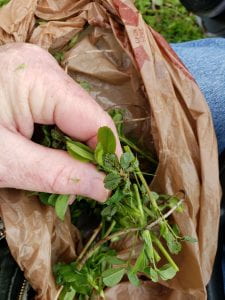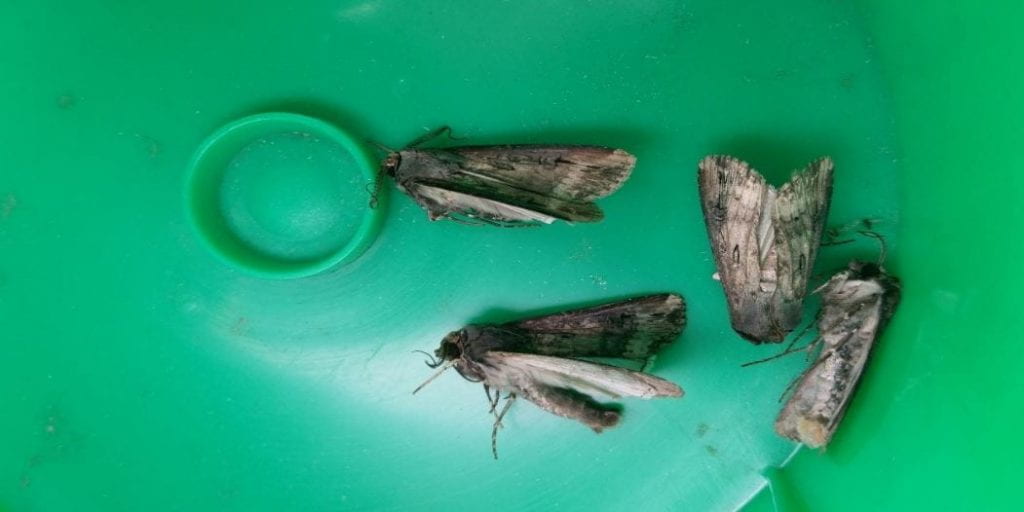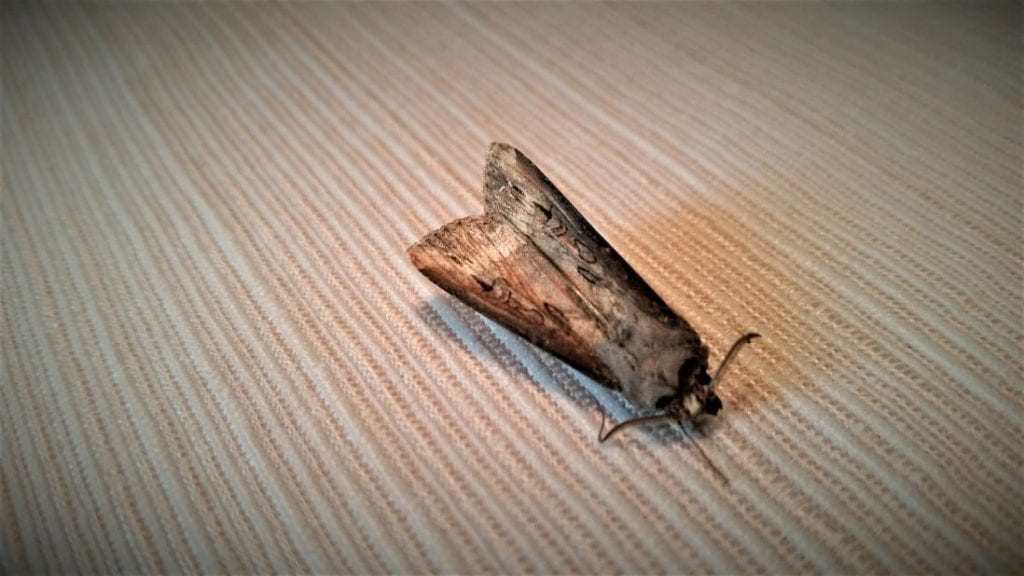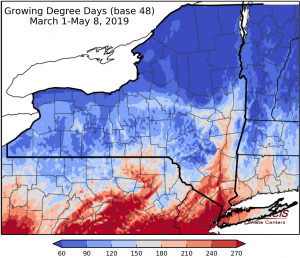Volume 18-Number 2
Contents
View from the Field
Jeff Miller (CCE Oneida County) reports finding spring black stem in alfalfa. Spring Black Stem: is favored by cool and moist weather in early spring. Symptoms appear as irregularly shaped brown to black spots that can merge to form a larger blotch. This disease can infect the petiole, form elongated blackened areas on the stems, and may be a contributor to a crown rot
The alfalfa snout beetle (ASB) spring emergence has begun in the North Country, reports Mike Hunter (CCE Northern NY). As the spring temperatures warm over the next week or so should enhance ASB viewing opportunities as adults of this unique species emerge and begin moving to new alfalfa fields.
Black cutworm moth captures increased this week. We had one trap in Lewis County with 93 moths this week. We only caught 7 armyworm moths this week. If fields can dry out and we can get corn planted you will want to monitor for black cutworm in newly emerging corn.
Weather Outlook – May 9, 2019
Jessica Spaccio
NOAA Northeast Regional Climate Center, Cornell University
Last week temperatures ranged from 4 degrees below normal to 6 degrees above normal. Precipitation has ranged from ¼” – 2”. Base 50 growing degree-days ranged less than 20 to 60.
After a short reprieve, a front will bring the return of rain on Friday. High pressure will give NY a dry day on Saturday, another low-pressure system brings showers on Sunday.
Today there will be increasing clouds with a chance of rain, but most areas will stay dry until the evening. Temperatures will range from the 50s to low 70s. Overnight lows will be in the 40’s to mid 50s, with showers spreading from west to east.
Friday will be in the 60s and mid 70s , a cold front will bring rain and isolated thunderstorms, with precipitation amounts ranging from a half inch to one inch. Overnight temperatures will be in the low 40s to low 50s, some areas could see frost.
Saturday temperatures will be in the mid 50s to mid 60s with dry conditions. Overnight temperatures will be in the 40s.
Sunday highs will be in the 50s with widespread showers likely. Overnight temperatures will be in the 40s.
Monday temperatures will be cooler, in the 40s and 50s with some showers possible. Overnight temperatures will be in the 40s.
Tuesday highs will be in the 50s to 60s with shows possible. Overnight temperatures will be in the 40s.
Wednesday highs will be in the upper 50s and lower 60s with rain possible. Overnight temperatures will be in the 50s.
The seven-day precipitation amounts will range from ¾” to 1.50”.
The 8-14 day outlook (May 16-22) favors below-normal temperatures for western to northern NY and above-normal precipitation for most of the state.
National Weather Service watch/warnings map
Black Cutworm Moths Are Here
Jaime Cummings and Ken Wise, NYS Integrated Pest Management Program
Black cutworm moths in a pheromone trap in Tompkins County on May 2 (photo by Jaime Cummings, NYS IPM).
Our statewide network of IPM and CCE staff, along with farmers and crop advisors set out pheromone traps for detecting migration of black cutworms (BCW) the first week of May across the state. Not surprisingly, based on reports of BCW moths from nearby states in weeks passed, we have received reports of low to moderately high numbers caught in several traps in the network (Table 1). We’ve heard that some private traps out in western NY have yielded higher numbers.
Table 1. Numbers of black cutworm moths in pheromone traps the first 2 weeks of May.
| County | Town | May 1 | May 12 |
| Delaware | Davenport Center | 0 | 6 |
| Dutchess | Amenia | 5 | 29 |
| Lewis | Martinsburg | 0 | 93 |
| Livingston | Caledonia | 0 | 0 |
| Livingston | Lima | 3 | 5 |
| Oneida | Kirkland | 4 | 4 |
| Oneida | Westmorland | 0 | 9 |
| Onondaga | Memphis | 0 | 0 |
| Seneca | Seneca Falls | 12 | 29 |
| Tompkins | Ulysses | 5 | 6 |
| Washington | Argyle | 4 | |
| Washington | Easton | 0 | 0 |
| Washington | Fort Edward | 1 | 3 |
| Washington | Stillwater | 3 | 4 |
| Wayne | Ontario | 1 | 1 |
| Wyoming | Castile | 0 | 19 |
| TOTAL | 38 | 208 |
The purpose of this pheromone trapping network is to monitor the arrival of these moths in the state so that we can establish a ‘biofix date’ to start counting growing degree days to help us know when we should expect larval damage in our fields. Table 2 outlines BCW life cycle and activities based on the accumulation of growing degree days. Note that it takes 90 growing degree days from the time moths arrive to the time the larvae hatch, and it’s the larvae that cause the damage. See table 3 for growing degree day calculations for select locations.
Table 2. Black Cutworm Degree Days
Degree Days Stage Feeding Activity
0 Moth Capture Egg Laying
90 Eggs Hatch
91-311 1st to 3rd Instar Leaf Feeding
312-364 4th Instar Cutting Begins
365-430 5th Instar Cutting Begins
431-640 6th Instar Cutting Slows
641-989 Pupa No feeding
Source: University of Minnesota Black Cutworm Trapping Network
Table 3. Growing degree days calculated for black cutworm at weather stations around NYS.
| Station Location |
Black Cutworm (Base 50) April 17 |
| Ceres | 77 |
| Chazy | 28 |
| Geneva | 38 |
| Highland | 72 |
| Ithaca | 49 |
| Massena | 38 |
| Valatie | 65 |
| Versailles | 59 |
| Watertown | 18 |
Keep an eye out for BCW larvae in your fields! And remember, the economic threshold for BCW treatment is reached when 5% or more plants in the stand have been cut or show signs of damage. The larvae are best controlled when small (< ½”), and soil-applied insecticide rescue treatments at the time of infestation is the most economical and effective management option for BCW infestations. Lorsban, Pounce and Warrior II all have efficacy against BCW (always consult labels for rates and instructions), and Poncho and Cruiser seed treatments are also labelled for BCW. Spot treatment is recommended for infested areas of fields, with a 20-40’ surrounding border. Replant may be necessary if the damage is too severe to manage with insecticide.
For updates on the progress of these monitoring efforts, please subscribe to the NYS IPM Weekly Pest Report.
Black cutworm moth (photo by Jaime Cummings, NYS IPM)
How to Monitor Alfalfa Weevil in Alfalfa.
Ken Wise, NYS IPM
Monitor alfalfa weevil weekly from mid to late-April through June. Because weevil populations can build up over the life of the alfalfa stand, monitoring fields that are two or more years in production are critical to determining infestation levels. Start weekly field sampling in fields at about 350 degree-days (base temperature 48F) which are about mid to late April in most years, but not this year!
- Pick 50 alfalfa stems at random throughout the field.
- Look for the small “shot holes” in the leaves that indicate that larvae are feeding.
- Record the percentage of alfalfa stems that show the “shot hole” feeding damage in the top 3 inches of the canopy.
Before the first cutting, if 40% of the stem tips show feeding damage, you are at the “action threshold”. The good thing is that alfalfa weevil can generally be controlled by harvesting. If you reach an action threshold within a week of your normal 1st cutting date, early harvesting will help avoid economic, yield, and forage quality losses. Alfalfa weevils only have one generation per year and are typically not a problem after the first harvest. Occasionally, weevil can damage alfalfa re-growth after harvest. This damage may be more evident in the windrow areas, and can be more noticeable under cool or droughty weather conditions. If you find that 50% of the new growth is damaged, with many small larvae present, chemical control may be warranted.
Source: NYS IPM, Growing alfalfa the IPM Way
Black Cutworm Moth Captures
| The week of | ||||
| County | Town | May 1 | May 12 | May 19 |
| Delaware | Davenport Center | 0 | 6 | |
| Dutchess | Amenia | 5 | 29 | |
| Lewis | Martinsburg | 0 | 93 | |
| Livingston | Caledonia | 0 | 0 | |
| Livingston | Lima | 3 | 5 | |
| Oneida | Kirkland | 4 | 4 | |
| Oneida | Westmorland | 0 | 9 | |
| Onondaga | Memphis | 0 | 0 | |
| Seneca | Seneca Falls | 12 | 29 | |
| Tompkins | Ulysses | 5 | 6 | |
| Washington | Argyle | 4 | ||
| Washington | Easton | 0 | 0 | |
| Washington | Fort Edward | 1 | 3 | |
| Washington | Stillwater | 3 | 4 | |
| Wayne | Ontario | 1 | 1 | |
| Wyoming | Castile | 0 | 19 | |
| TOTAL | 38 | 208 |
True Armyworm Moth Captures
| The week of | ||||
| County | Town | May 1 | May 12 | May 19 |
| Dutchess | Amenia | 0 | 0 | |
| Delaware | Davenport Center | 0 | 0 | |
| Livingston | Lima | 1 | 2 | |
| Oneida | Kirkland | 0 | 1 | |
| Oneida | Westmorland | 0 | 3 | |
| Onondaga | Memphis | 0 | 0 | |
| Lewis | Martinsburg | 0 | 0 | |
| Livingston | Caledonia | NA | 1 | |
| Washington | Argyle | 0 | 0 | |
| Washington | Easton | 0 | 0 | |
| Seneca | Seneca Falls | 0 | 0 | |
| Wayne | Ontario | 0 | 0 | |
| Tompkins | Ulysses | 0 | 0 | |
| Wyoming | Castile | 0 | 0 | |
| TOTAL | 1 | 7 |
Field Crops Insect Pest Degree Days Pest Models
Growing degree Days for peak (50%) Occurrence of Alfalfa Weevil growth stage:
| Stage |
Degree Days (Base 48) |
| Egg | 280 |
| Instar 1 | 351 |
| Instar 2 | 395 |
| Instar3 | 470 |
| Instar 4 | 550 |
| Cocooning | 600 |
| Pupa | 725 |
| Adult Emergence | 815 |
(Note: for alfalfa weevil predictions use Base Temp of 48F)
Seed Corn Maggot Peak Flight and Fly Maggot Free Degree Days
| Base Temp = 390 F | Peak 1st Generation | Seed corn maggot fly free degree days | Peak 2nd Generation | Seed Corn maggot fly free degree days | Peak 3rd Generation | Seed Corn Maggot fly Free degree days |
| degree days | 360 | 810 | 1,080 | 1530 | 1800 | 2250 |
Source: Insect IPM for Organic Field Crops: Seed Corn Maggot by Katelin Holm and Eileen Cullen
Black Cutworm Degree Days
Degree Days Stage Feeding Activity
0 Moth Capture Egg Laying
90 Eggs Hatch
91-311 1st to 3rd Instar Leaf Feeding
312-364 4th Instar Cutting Begins
365-430 5th Instar Cutting Begins
431-640 6th Instar Cutting Slows
641-989 Pupa No feeding
Source: University of Minnesota Black Cutworm Trapping Network
2019 New York Field Crop Pest Degree-Day Accumulations for selected locations
| Station Location |
Alfalfa Weevil (Base 48) March 1 |
GDDs (Base 50 F) March 1 |
Seed Corn Maggot (base 39) January 1 |
Black Cutworm (Base 50) April 17 |
| Ceres | 197 | 144 | 533 | 77 |
| Chazy | 84 | 56 | 319 | 28 |
| Geneva | 141 | 94 | 477 | 38 |
| Highland | 260 | 198 | 676 | 72 |
| Ithaca | 188 | 130 | 550 | 49 |
| Massena | 100 | 64 | 337 | 38 |
| Valatie | 217 | 165 | 590 | 65 |
| Versailles | 179 | 128 | 553 | 59 |
| Watertown | 74 | 43 | 353 | 18 |
Clipboard Checklist
Keith Waldron, NYS IPM
General
*Walk fields to check tile flow, check and clear drainage outlets. Look for line breaks
*Note and record location of wet areas on field maps or aerial photo for future tiling considerations and crop decisions, check for areas of soil erosion
*Pre-plant weed evaluation, timing cultivation and/or pre-plant weed management
*Watch for early season weeds: winter annuals, chickweed, henbit, field penny cress, shepherd’s purse, giant and common ragweed, purple deadnettle, lambsquarters, redroot pigweed, velvet leaf, Pennsylvania smartweed, common sunflower, quackgrass, foxtail
Alfalfa:
*Evaluate established legume stands for winter damage (thinning stand, frost heave, Brown root rot), determine average alfalfa stand count adjust crop plans if necessary
*Monitor for alfalfa weevil, crown or foliar diseases
*Monitor new seedings for Pythium blight and Phytopthora Root Rot.
*Monitor for Alfalfa Snout Beetle (In Oswego, Jefferson, Cayuga, Wayne, Lewis, St. Lawrence, Clinton, Essex, and Franklin counties)
Small Grains:
*Monitor winter grain fields for over wintering survival (snow mold and other cold injury issues), weed issues (such, as winter annuals, corn chamomile and chickweed), growth stage, number of tillers, foliar diseases (powdery mildew, rusts)
*Check stands for soilborne virus diseases, Wheat spindle streak mosaic and Soilborne wheat mosaic, check for signs of powdery mildew or other maladies, cereal leaf beetle, weed escapes, goose damage
Corn:
*Prepare land and plant corn as conditions allow
*Pre-plant weed evaluation, timing cultivation and/or pre-plant weed management
*Emergence: assess stand, population count
Soybeans:
*Prepare land and plant soybeans as conditions allow
*Pre-plant weed evaluation, timing cultivation and/or pre-plant weed management
Pastures:
*Check and mend fences as needed.
*Check crop growth
*Monitor fields for invasive species, plants harmful to livestock
*Review/Plan rotation system
Equipment:
*Remove / clean soil and crop debris from equipment
*Arrange for custom weed control or check your own application or cultivator equipment for repairs.
*Carry appropriate / necessary NYS DEC and EPA required documents: (pesticide applicators license, pesticide labels, MSDS sheets, etc.) with application equipment
*Calibrate:
-planting equipment – maintain records on planting rate per field
-manure spreaders – maintain records on amount spread per field
-pesticide application equipment – Check nozzles, pumps, etc., recalibrate pesticide application equipment before use.
Storage:
* Check stored grain bins for temperature, moisture and signs of mold and insects. Aerate, core, transfer grain or treat as necessary
*Check forage allocation and anticipate feed program adjustments as forages from previous year are used up
*Plan where forages should be stored for optimum allocation next feeding season





